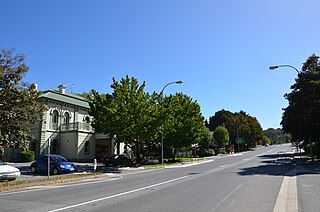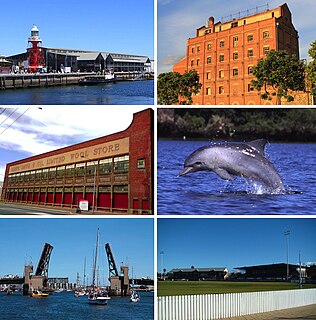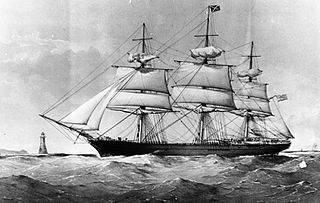
The Advertiser is a daily tabloid format newspaper published in the city of Adelaide, South Australia. First published as a broadsheet named The South Australian Advertiser on 12 July 1858, it is currently a tabloid printed from Monday to Saturday. The Advertiser came under the ownership of Keith Murdoch in the 1950s, and the full ownership of Rupert Murdoch in 1987. It is now a publication of News Corp Australia. Through much of the 20th century, The Advertiser was Adelaide's morning broadsheet, The News the afternoon tabloid, with The Sunday Mail covering weekend sport, and Messenger Newspapers community news. The head office was relocated from a former premises in King William Street, to a new News Corp office complex, known as Keith Murdoch House at 31 Waymouth Street.

The town of Crafers is in the Adelaide Hills to the south-east of Adelaide, South Australia. Although technically considered to be an outer suburb of Adelaide, with many residents commuting to the city to work, locals consider Crafers to be more a suburb of the nearby township of Stirling.

The South Eastern Freeway is a 76 kilometre controlled-access highway in South Australia. It carries traffic over the Adelaide Hills between Adelaide and the River Murray, near Murray Bridge, connecting via the Swanport Bridge to the Dukes Highway which is the main road route to Victoria. It is often referred to by South Australians simply as the Freeway, as it was the first freeway in South Australia, and is still the longest, and the only one with "Freeway" in its name rather than "Expressway" or "Highway". It is a part of the National Highway network linking the state capital cities Adelaide to Melbourne and signed as National Highway M1. The South Eastern Freeway includes 500-metre-long twin-tube tunnels in the descent towards Adelaide, the first of their kind on the National Highway. It is designated as the M1.

Hahndorf is a small town in the Adelaide Hills region of South Australia. Currently an important tourism spot, it has previously been a centre for farming and services.

Mount Lofty is the highest point in the southern Mount Lofty Ranges. It is located about 15 km east of the Adelaide city centre in South Australia, and has panoramic views of the city and the Adelaide plains to the west, and of the Picadilly Valley to the east.

Port Adelaide is a port-side region of Adelaide, approximately 14 kilometres (8.7 mi) northwest of the Adelaide CBD. It is also the namesake of the City of Port Adelaide Enfield council, a suburb, a federal and state electoral division and is the main port for the city of Adelaide. Port Adelaide played an important role in the formative decades of Adelaide and South Australia, with the port being early Adelaide's main supply and information link to the rest of the world. Its Kaurna name, although not officially adopted as a dual name, is Yartapuulti.
This is a timeline of Adelaide history.

Mount Torrens is a town in the eastern Adelaide Hills region of South Australia, 46 kilometres east-north-east of the state capital, Adelaide and 8 km east of Lobethal. It is located in the Adelaide Hills Council and the Mid Murray Council local government areas. At the 2006 census, Mount Torrens had a population of 337.

Adolph Heinrich Friedrich Bartels was a German-born Australian politician. He was Mayor of Adelaide 1871–1873.

Horsnell Gully Conservation Park is a protected area in the Australian state of South Australia in the locality of Horsnell Gully located about 9 kilometres (5.6 mi) east of the state capital of Adelaide and about 32 kilometres (20 mi) southwest of Norton Summit.

North Adelaide is a predominantly residential precinct and suburb of the City of Adelaide in South Australia, situated north of the River Torrens and within the Adelaide Park Lands.

The Adelaide Football Club, often referred to as the Old Adelaide Football Club, was an Australian rules football club based in Adelaide. Founded on 26 April 1860, it was the first football club formed in South Australia.

Bugle Ranges is a locality on the Adelaide Hills of South Australia. It lies between Mount Barker and Strathalbyn, both by road and on the Victor Harbor railway line.

The District Council of Highercombe was a local government area in South Australia from 1853 to 1935.
John Carruthers was a surveyor in South Australia, who fixed the boundary between the Northern Territory and Queensland.

Yatala, 1,127 tons, was a clipper ship built in 1865 for the Orient Line. She traded to South Australia from London for seven years until she was wrecked on 27 March 1872, near Cape Grisnez, France. Until the advent of Torrens, she was arguably the fastest on the route. Her only master was Captain John Legoe, previously of Celestial and The Murray.
Daniel Garlick was an architect in the early days of South Australia. After his death two competing firms of architects claimed his aegis in their partnership names.
The Hindmarsh Brewery was a brewery founded c.1844 in Hindmarsh, in the then colony of South Australia, by E. J. F. "Fred" Crawford. Crawford lost possession of the business in 1859, then re-established it on a different site before becoming bankrupt. It was then taken over by Henry Haussen and George Catchlove, and was successfully operated by them and their successors until 1927.
Walkerville Brewery was a brewer of beer in Adelaide, South Australia, originally founded in the 1840s. The company became a co-operative, and grew by admitting hotel owners as shareholders, and absorbed smaller breweries. After several amalgamations it moved its operations to Southwark and by 1920 it was South Australia's largest brewing company.

William Williams was an early settler in the Province of South Australia, known for establishing the Walkerville Brewery and his work on the Kaurna language. He was Deputy Colonial Storekeeper for some time.
















